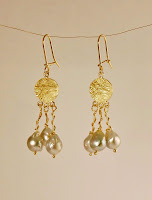
In my last blog entry I mentioned a young gent in with his fiancee who simply wanted to make her happy. The ring pictured above is the band they ended up with. It's a variation on one of my favorite and best selling designs with a combination of a prong setting and bezel settings. As it happens I have another order in house for the same band in platinum with all diamonds but it was set up a little differently and I'll post that when it is finished.

I've also been busy trying to get some new stock out. I haven't had a chance to catch up from the holiday season until now and I'm happy to report I have a number of new earrings out right now. The picture above this paragraph is one of them. I'll be posting some more pictures of new pieces in the days to come.
I have had a number of people in recently who have either lost or had pieces of jewelry stolen and are trying to deal with their insurance companies about the matters. What always seems to come out in these discussions is that the customers seem to have no idea of what the insurance company's rules and coverage limitations are----at least until after they lose a piece. So I want to give you a few tips when insuring jewelry.
1) If you are insuring jewelry through your homeowner's or renter's insurance policy you need to look into how much is automatically covered with their general policy and what you will need to add riders for. Most insurance policies carry some small amount of general insurance against jewelry theft or loss without the need for appraisals or riders. But you need to know how much that is!!! Because of today's metal markets it becomes even more important because a piece you bought ten years ago is worth so much more today that even if you didn't need a rider when you bought it, you might now. So YOU NEED TO ASK IF YOUR POLICY COVERS YOU WHEN PRICES RISE AS THEY HAVE RECENTLY or whether you need to update your appraisals.
2) INSURANCE COMPANIES WILL NOT ALWAYS TELL YOU WHEN YOU NEED TO HAVE JEWELRY VALUES UPDATED. Most insurance companies want to pay out as little as possible under any circumstances and if they've been collecting on a $2000 piece for ten years and then suddenly it's worth $6000 and is lost they don't want to pay out the higher price.
3) You need to clearly understand their deductibles. If they offer you $5000 in automatic coverage but you have a $2500 deductible on jewelry then you are going to be out a lot of money if you want to replace the piece.
4) Most insurance companies (not all) will no longer pay out cash to the customer in the event of a loss. They will only pay a jeweler directly. You need to know if this is the case, especially if you are insuring pieces that might be irreplaceable (true antiques).
5) Most insurance companies try to make you go to a jeweler they work with for replacement pieces. This doesn't work well for you in the event that you own a piece made by someone like me or another designer jeweler. The reason they do this is that they have deals cut with the jeweler for highly discounted prices because of how much business they send them. In my opinion this is unfair to the client as you are paying insurance as if they are going to replace it at full stated value but they aren't going to do that. It may be fine for you if you own fairly commercial jewelry but it just won't work if you have something unique.
6) In the event that you own a designer's piece you have to be prepared to fight for your right to get the same piece (or something equivalent) made by the same designer. Insurance companies (along with much of the general public) don't believe that jewelry can be copyrighted. Because of this they will often try to get quotes from multiple jewelers even when the piece is a distinct, unique, copyrighted piece. Copyright is inferred automatically upon production of a unique piece and it does not need to be registered with the Federal copyright office to have all the protections accorded under copyright law. Consequently if you tell them you have a unique designer piece and you want to replace it with the same thing, it is ILLEGAL for them to demand you go to another jeweler (unless it's a designer who sells his work at a variety of locations---but you still are entitled to a piece by the same designer). So you need to check on what the insurance company will do if you are insuring a designer piece with them before you agree to their coverage policies.
7) It is my general advice that you find an insurance company that will allow you to go to the jeweler of your choice. Jewelers Mutual, the insurance company I use to cover my store, is a company dedicated solely to insuring jewelry. Consequently they know more about the industry than any other. They offer a personal insurance plan for your jewelry known as Perfect Circle and you can access them by going to
www.PerfectCircleinsurance.com/Moments.
They allow you to go to the jeweler of your choice.
So remember ask questions! They won't volunteer the answers and it's up to you to know what is and what isn't covered.
The ring at the top is 18k gold with a purple sapphire, orange sapphire and diamond. The earrings are 18k gold with natural color grey baroque cultured saltwater pearls that come from old stock and, to the best of my knowledge, cannot readily be found anymore.


